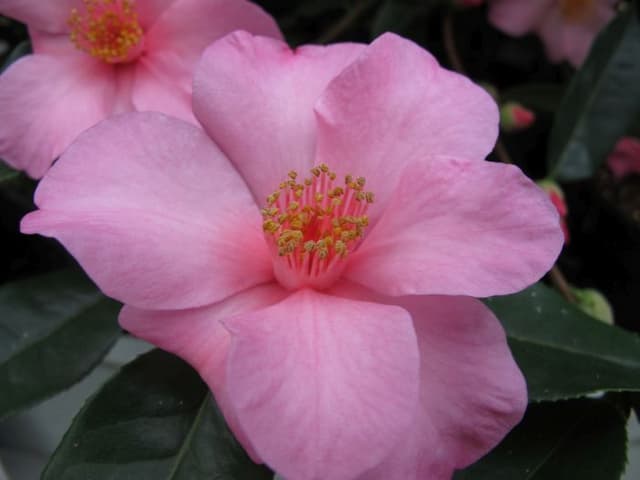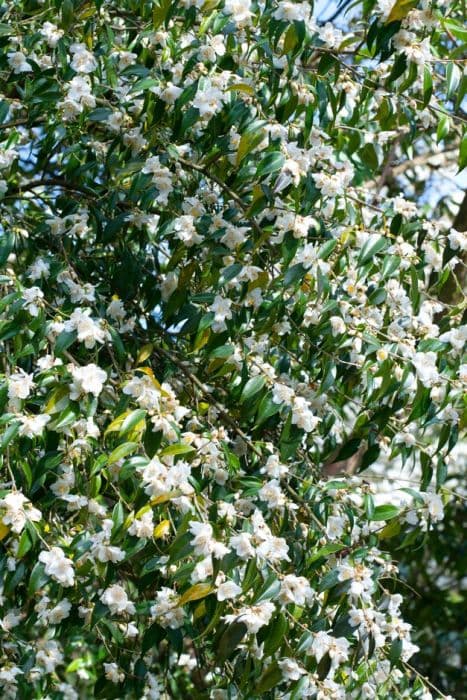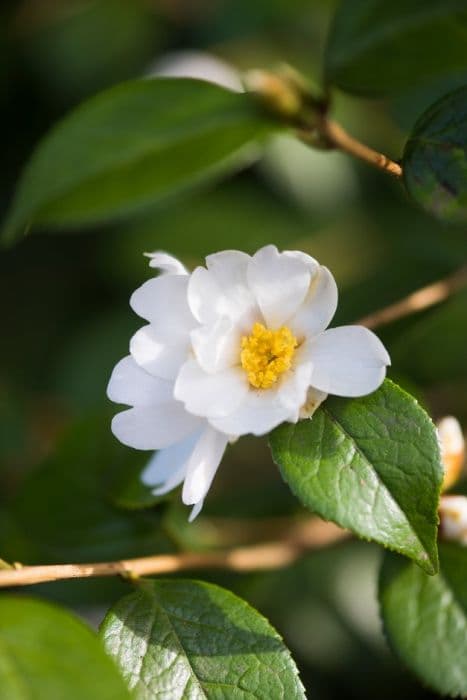Camellia Camellia × williamsii 'Elsie Jury'

ABOUT
The Camellia 'Elsie Jury' is a visually striking shrub known for its exquisite flowers and lush, evergreen foliage. The plant showcases large, peony-form blooms, which mean the flowers are full and rounded with numerous overlapping petals that create a dense and fluffy appearance. These blossoms flaunt a rich pink color, drawing the eye with their vibrant hue. The flowers possess a subtle, irresistible charm, and during the blooming season, they stand out against the glossy, deep green leaves of the shrub. The leaves themselves are quite attractive; they are leathery to the touch, with a smooth, shiny surface and a classic oval shape with slight serrations along the edges. This combination of sumptuous blooms and verdant foliage makes the Camellia 'Elsie Jury' a favorite among garden enthusiasts seeking to add a touch of elegance and color to their landscapes.
About this plant
 Names
NamesFamily
Theaceae
Synonyms
Williamsii Camellia, Elsie Jury Camellia
Common names
Camellia × williamsii 'Elsie Jury'.
 Toxicity
ToxicityTo humans
Camellia plants, including the Camellia × williamsii 'Elsie Jury', are generally considered non-toxic to humans. There are no well-documented cases of poisoning from ingesting parts of the camellia plant, which means that they are unlikely to cause any significant health issues if accidentally consumed. However, as with any non-food plants, it is still recommended to avoid ingesting them as a precaution.
To pets
Camellias, including the Camellia × williamsii 'Elsie Jury', are also generally considered non-toxic to pets such as cats and dogs. They are not listed among the common toxic plants that pose a risk to household animals. Thus, ingestion of this plant's leaves or flowers is unlikely to cause poisoning or severe symptoms in pets. Despite its non-toxic status, pet owners should still prevent pets from eating non-food plants to avoid potential gastrointestinal upset or other non-toxic reactions.
 Characteristics
CharacteristicsLife cycle
Perennials
Foliage type
Evergreen
Color of leaves
Dark green
Flower color
Pink
Height
6-10 feet (1.8-3 meters)
Spread
6-10 feet (1.8-3 meters)
Plant type
Shrub
Hardiness zones
7
Native area
Japan China
Benefits
 General Benefits
General Benefits- Aesthetic appeal: The Camellia Elsie Jury, known for its beautiful, large, pink flowers, provides visual interest to gardens and landscapes.
- Seasonal interest: Blooming in late winter or early spring, it offers color and life at a time when many other plants are dormant.
- Low maintenance: Once established, the Elsie Jury is relatively low maintenance, requiring minimal care beyond occasional pruning and watering during dry periods.
- Longevity: Camellias are known for their long life span, with some specimens surviving for over a century, making them a legacy plant for a garden.
- Versatility: This plant can be used in various landscape designs, including formal gardens, woodland settings, and containers.
- Privacy and screening: When planted in groups or as a hedge, the Elsie Jury can provide privacy and screen unsightly views.
- Wildlife value: The flowers of the Elsie Jury may attract pollinators such as bees, contributing to the health of your garden ecosystem.
 Medical Properties
Medical PropertiesThis plant is not used for medical purposes.
 Air-purifying Qualities
Air-purifying QualitiesThis plant is not specifically known for air purifying qualities.
 Other Uses
Other Uses- Culinary Decoration: The Camellia 'Elsie Jury' flowers can be used to decorate cakes and desserts, adding a splash of color and an exotic touch to the presentation.
- Textile Dye: Petals of 'Elsie Jury' can be used in the process of natural dyeing, imparting delicate shades to fabrics.
- Photography: The vibrant blooms serve as an excellent subject for macro and nature photography, providing a captivating focal point.
- Handmade Paper: Incorporated into handmade paper, the petals of 'Elsie Jury' can provide texture and visual interest to the finished product.
- Artistic Inspiration: Artists may use the form and color of the 'Elsie Jury' as inspiration for paintings, illustrations, and other artistic creations.
- Eco-friendly Confetti: Dried petals of 'Elsie Jury' can be used as biodegradable confetti for eco-conscious celebrations and events.
- Crafts: Fresh or dried flowers can be used in crafting, such as making bookmarks or floral candle arrangements.
- Aromatherapy: Though not directly used for its scent, 'Elsie Jury' can be included in potpourri mixes for a mild aroma and visual appeal.
- Education: Camellia 'Elsie Jury' plants can be used as a teaching tool in botany and horticulture courses, illustrating hybridization and flower structure.
- Floral Languages and Symbolism: Camellias can be used in the context of floriography—the language of flowers—to convey messages of admiration and perfection.
Interesting Facts
 Feng Shui
Feng ShuiCamellia is not used in Feng Shui practice.
 Zodiac Sign Compitability
Zodiac Sign CompitabilityCamellia is not used in astrology practice.
 Plant Symbolism
Plant Symbolism- Adoration: Camellia flowers, which include Camellia × williamsii 'Elsie Jury', often symbolize deep adoration or admiration, making them ideal gifts to express such feelings.
- Perfection: The symmetry and beauty of camellias often represent the idea of perfection or a flawless character in the language of flowers.
- Longevity: Camellias are evergreen and long-living plants, leading them to be associated with long life and enduring faithfulness.
- Love: These flowers carry various meanings related to love, from the longing for a loved one to the passionate desire associated with deep red hues.
- Affection: Gifting camellias can symbolize a genuine, sincere affection towards someone.
 Water
WaterThe Williamsii Camellia, commonly known as 'Elsie Jury', requires even moisture and should be watered when the top inch of soil feels dry. This typically means watering once or twice per week, but frequency can vary with weather conditions. Provide deep watering to encourage root growth rather than frequent light sprinklings. Each watering should consist of 1 to 1.5 gallons of water, ensuring the plant is hydrated but not waterlogged. During the winter months, reduce watering as the plant requires less moisture during its dormant period.
 Light
LightWilliamsii Camellias, including the 'Elsie Jury' variety, thrive in partial shade to dappled sunlight. They should be placed in a location where they are protected from the hot afternoon sun. An ideal spot is under the canopy of tall trees that provide filtered light; this will prevent the leaves from being scorched by direct, harsh sunlight.
 Temperature
TemperatureWilliamsii Camellias like 'Elsie Jury' prefer temperate conditions and are hardy in temperatures as low as 5 degrees Fahrenheit but no higher than 85 degrees Fahrenheit. They perform best in climates where the average temperature remains around 60 to 75 degrees Fahrenheit. If the temperature drops significantly below 5 degrees, the camellias should be protected from the cold to prevent damage.
 Pruning
Pruning'Elsie Jury' Williamsii Camellias should be pruned for shaping and removal of dead or excess branches, which will promote healthier growth and flowering. The best time to prune is just after the blooming period in spring when new growth is minimal. Prune sparingly as camellias do not require heavy pruning, and annually or biannually is generally sufficient.
 Cleaning
CleaningAs needed
 Soil
SoilThe Williamsii Camellia, or Camellia × williamsii 'Elsie Jury', thrives in acidic soil with a pH of 5.5 to 6.5. A well-draining soil mix composed of 1/3 peat moss, 1/3 pine bark, and 1/3 perlite or vermiculite is ideal to support healthy growth and flowering.
 Repotting
RepottingWilliamsii Camellias generally need repotting every 2 to 3 years. It's best to repot in the spring before new growth begins, using the above-mentioned acidic soil mix to refresh the growing environment.
 Humidity & Misting
Humidity & MistingWilliamsii Camellias require moderate to high humidity levels, between 50% and 70%. Consistent humidity supports the plant's growth and bloom cycle while preventing stress.
 Suitable locations
Suitable locationsIndoor
Place Williamsii Camellias in a bright spot with indirect light indoors.
Outdoor
Plant Williamsii Camellias in partial shade with shelter from wind.
Hardiness zone
7-9 USDA
 Life cycle
Life cycleCamellia × williamsii 'Elsie Jury', commonly known as hybrid camellia, begins its life as a seed, which germinates in moist, well-drained soil, ideally under partial shade. After germination, the seedling goes through vegetative growth, developing a root system and foliage. It matures over several years, forming a woody structure and evergreen leaves. Once mature, the hybrid camellia produces buds in late autumn that bloom into large, showy flowers, typically pink, from winter to spring. After pollination, which is often facilitated by insects, the plant sets seed contained within a fruit that matures by autumn, ready to disperse and start the next generation. The hybrid camellia can live for many years, continuing its cycle of growth, flowering, and seed production annually.
 Propogation
PropogationPropogation time
Spring-Early Summer
The Camellia × williamsii 'Elsie Jury', commonly known as the Elsie Jury Camellia, is most frequently propagated through semi-hardwood cuttings. This method is generally undertaken during the summer months when the new growth has begun to mature but is not fully hardened. To propagate, cuttings of about 4 to 6 inches (approximately 10 to 15 centimeters) in length are taken from the semi-hardwood stems. Each cutting should have several leaves left at the top, with the lower leaves removed to facilitate planting. The cut end can be dipped in rooting hormone to encourage root development and then the cutting is inserted into a potting mix designed for cuttings. These cuttings should be kept in a warm, humid environment, often under a plastic cover or in a greenhouse, to retain moisture and warmth, which are critical for the rooting process. With proper care, the cuttings will develop their own root systems in a few weeks to a few months, after which they can be transplanted into individual pots or into the garden.









